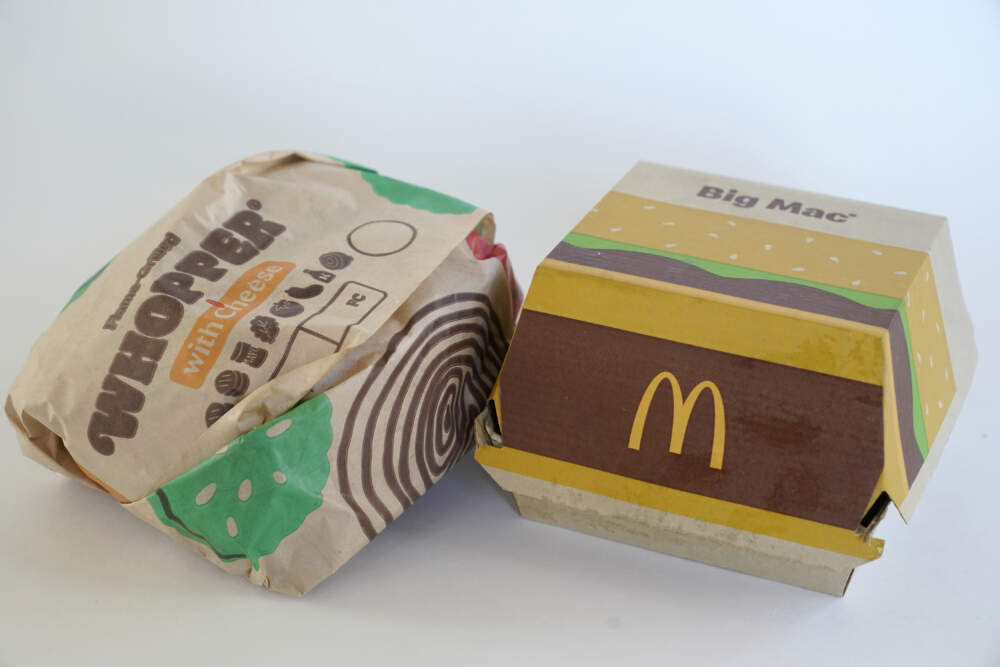Advertisement
Maine environmental regulators move to ban PFAS in food packaging

Maine environmental regulators are moving forward with plans to ban the sale of food packaging made with PFAS, joining a small but growing number of states targeting a potential exposure pathway to the “forever chemicals.”
For years, many food packaging manufacturers — including some with factories in Maine — have used PFAS coatings to keep paper-based containers from turning into soggy, greasy messes. But the same durable chemical bonds that make PFAS so useful in nonstick cookware, waterproof fabrics and food packaging also prevent the compounds from breaking down easily in the body and the environment, hence the nickname "forever chemicals.”
A growing body of scientific studies have also linked some PFAS to health problems such as cancer, kidney disease, low birth weight and disruption of the endocrine system.
Maine was the second state — after Washington — to pass a law in 2019 aimed at removing PFAS from fast-food wrappers, pizza boxes, picnic plates, take-out containers and other single-use food packaging. Rather than blaze a new trail, Maine lawmakers opted to rely on Washington’s planned analysis of whether there were safer, affordable alternatives available in the marketplace before banning containers made with PFAS.
Two studies later, Washington began prohibiting some food containers in February. And earlier this month, the Maine Department of Environmental Protection released concept draft language for rules that would ban PFAS in nine types of food packaging.
DEP Commissioner Melanie Loyzim said she hopes the Maine Board of Environmental Protection and the Legislature will approve the final rules next year. But she described the proposal as being part of Maine’s two-pronged approach to address both existing contamination and the PFAS still showing up in the waste stream.
"We've got it still coming into our waste stream and it's coming from things like PFAS in food packaging and PFAS in products,” Loyzim said in an interview last week. “So if we want to try to get it out of our waste stream and not have it continue to go into our environment, we have to do source reduction. And this is going to be an important part of that strategy."
Short for per- and polyfluoroalkyl substances, PFAS is a family of more than 10,000 chemicals that are widely used in consumer products as well as high-tech equipment and firefighting foam. But the long-lasting chemicals are showing up in water supplies across the country. And in Maine, testing has revealed dangerously high levels of older, toxic versions of PFAS in dozens of farm fields where sludge was used as fertilizer as well as in nearby wells and water sources.
Maine was the first state to require PFAS testing of sludge and later banned re-purposing the waste as farm fertilizer. Lawmakers also made headlines two years ago when they passed a first-in-the-nation bill to ban PFAS in all products sold in the state by 2030.
But before that happens, Maine environmental regulators want to remove PFAS from food packaging.
"In this particular instance, we are a little bit in the middle of the pack. Usually on PFAS we are leading,” said Sarah Woodbury, who works on PFAS policy issues with the Portland-based organization Defend Our Health.
While Woodbury said several other states have moved faster, she added that it made sense for Maine to piggyback on Washington's work on identifying safer alternatives.
"Our markets might be slightly different, but in the grand scheme of things, food packaging is food packaging,” Woodbury said. “And so we know what is out there for alternatives so it makes sense to base the alternatives off of what Washington state has done and kind of utilize all of their hard work instead of remaking the wheel to try to do our own thing."
The packaging industry has been heavily involved in state house policy discussions from Augusta to Olympia to Sacramento. A representative for the American Institute for Packaging and Environment declined to comment for this story but says the trade group would formally respond to the Maine DEP's draft rules.
Erika Schreder, science director at the Seattle-based group Toxic-Free Future, said she hasn't heard about any container shortages since Washington began rolling out its new rules in February.
"What we have heard is that the major manufacturers of food packaging in the United States have all now moved away from PFAS,” Schreder said.
Schreder said that as more states take action, major chains like McDonald's, Whole Foods and Starbucks have announced they are switching to PFAS-free packaging. The same thing happened more than a decade ago when health concerns prompted Washington and Maine to ban certain flame retardant in carpets, upholstered furniture and appliances. Other states followed suit and manufacturers changed the formulations.
"We've seen over the years that when states pass laws, companies pay attention and they start moving toward safer alternatives,” Schreder said. “And this has been happening for decades."
Maine's prohibition would only apply to manufacturers with more than $1 billion in sales. The DEP’s Loyzim said the aim is to capture the market leaders without harming smaller producers.
"Hopefully this sort of gets at the biggest and largest sources that are in distribution,” Loyzim said. “If we find after implementation there are entities that have been excluded that may be major contributors to PFAS in the waste stream, that is certainly a limit that can always be revisited by the Legislature."
Loyzim added that the DEP is just starting the lengthy rulemaking process. Both the Maine Board of Environmental Protection and the Legislature must ultimately approve the rules.
This story is a production of the New England News Collaborative. It was originally published by Maine Public.